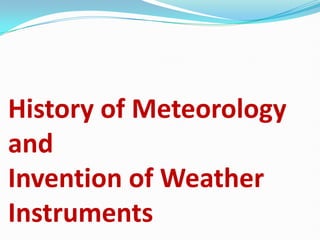
History of meteorology and invention of weather instruments
- 1. History of Meteorology and Invention of Weather Instruments
- 2. The word 'meteorology' was coined from a research book called 'Meteorologica' which was written by Aristotle, a Greek scientist and philosopher. This early work described the science of earth like its geology, elements, hydrology, seas, wind and weather. In the modern term, the term meteorology explains a complete science. It is for understanding the dynamics of atmosphere and forecasting weather phenomena like hurricanes and thunderstorms.
- 3. In Bible times the forecasting of weather conditions was based solely upon observations of the sky. This is alluded to in the Bible book of Matthew where Jesus says to the religious leaders of the 1st Century, "˜You are able to interpret the appearance of the sky but the sign of the times you cannot interpret.' This method of simple observation prevailed until 1643 when Italian physicist Evangelista Torricelli invented the barometer. This simple device was able to measure the pressure of the air. Torricelli noticed that air pressure changes in accordance with changes in the weather. In fact a drop in pressure would often signal that a storm was coming. Atmospheric humidity was also able to be measured when the hygrometer was invented in 1644. Then in 1714 German physicist Daniel Fahrenheit developed the mercury thermometer. It was now possible to accurately measure the weather.
- 4. It was in 1765 that daily measurements of air pressure, moisture content,wind speed and direction began to be made. This was first done by French scientist Laurent Lavoisier who stated,"With all of this information it is almost always possible to predict the weather one or two days ahead with reasonable accuracy." However things were not as simple as Lavoisier had thought. In 1854 a French warship and 38 merchant vessels sank in a fierce storm off the Crimean port of Balaklava. The director of the Paris Observatory was asked to investigate the disaster. On checking meteorological records it was seen that the storm had actually formed two days previous to the sinkings and had swept across Europe from the southeast. If a tracking system had been in place the ships could have been warned of the pending danger. As a result of these findings a national storm warning service was set up in France. This is recognized as the start of modern meteorology.
- 5. Aneroid barometers are instruments used for measuring the pressure of the air in the atmosphere. They weren't invented until the 1840s—years after Franklin's time. High or rising pressure means that clear, sunny weather is expected, while falling or low pressure is a sign of rain or an approaching storm. As air pressure increases, it pushes down on a metal diaphragm, which in turn causes the indicating needle to move. This aneroid barometer was made in Germany and sits on an octagonal wooden base.A sling psychrometer, the simplest type of hygrometer, measures the relative humidity of the surrounding air by comparing the temperatures of one dry and one wet bulb thermometer. A small chain on the end of the wooden handle attaches the thermometers to each other. The psychrometer is spun around rapidly for a few minutes and readings are taken from the dry and wet bulbs. After these readings are taken, there is a scale that is used to correlate the readings. The relative humidity is read at the intersection of the RH scale and the wet bulb temperature.
- 6. Minimum-Maximum thermometer. It is used to record the highest and lowest temperatures observed over a 24-hour period. There are many uses for a minimum-maximum thermometer; one example would be to measure how low the temperature dropped in a greenhouse overnight to figure out exactly when it gets too cold for the plants or flowers to survive. This particular thermometer was made by W.H. Kessler Co., Inc.AnemometerWind velocity or speed is measured by a cup anemometer, an instrument with three or four small hollow metal hemispheres set so that they catch the wind and revolve about a vertical rod. An electrical device records the revolutions of the cups and calculates the wind velocity. The word anemometer comes from the Greek word for wind, "anemos."
- 7. ThermometerA thermometer containing either liquid mercury or colored alcohol measures the temperature by allowing the liquid to expand and rise as the temperature increases, and by allowing the liquid to contract and fall when the temperature decreases. Rain GaugeA rain gauge measures the amount of rainfall during a certain period of time. It is useful to help scientists determine whether or not there is a shortage of water or a drought in effect.Weather SatelliteWeather satellites are used to see the "big picture" system from space. The data taken by these satellites are analyzed using a computer.
- 8. Weather satellites orbit the Earth and provide weather information. Satellites can take pictures of the clouds, measure wind speeds, measure humidity, and determine temperatures at various altitudes. Weather balloons carry electronic equipment called radiosondes. This equipment measures temperature, air pressure, and relative humidity. Radiosondes have radio transmitters that send measurement to stations on the ground. Radar is used to find the location, movement, and strength of precipitation. Many television weather reports use doppler radar to show the location of precipitation on a map. Doppler radar is also used to predict a tornado up to twenty minutes before it touches the ground.
- 9. Prepared by:Rosanna C. RamosBSED I-BMs.KatrinaPobre